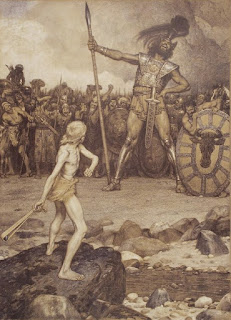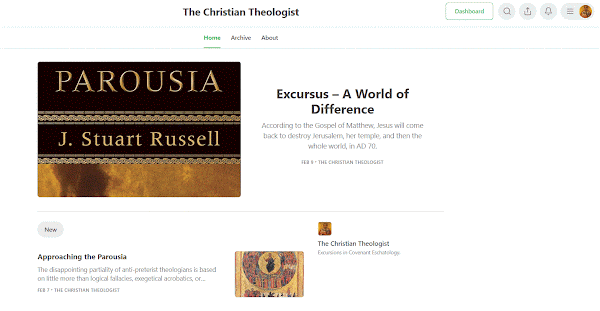Who Slew Goliath?
Another unfortunate KJV-Onlyist attempt at "Gottcha"!
David and Goliath, by Osmar Schindler (c. 1888)
Spend any time at all in the comment sections under Christian Youtube videos and you’re bound to run into the dreaded cultic KJV-onlyist. I am intimately familiar with these people, and their way of thinking, because I used to hold similar beliefs regarding the Textus Receptus. Without getting into the whole controversy (see James White's excellent video series here for more details), let's just say that these people are, for the most part, well-meaning but unsophisticated believers who are sadly ill-informed about the process of translation and the vital field of textual criticism. This lack of understanding results in their mischaracterization of the KJV as an inviolate and unimpeachable biblical text--the standard English Bible from which any deviation is deemed satanic heresy. Recently, upon citing a verse from the ESV, I was immediately challenged by one of these unfortunates.
In his breathless haste to show me the errors of my ways (which, true to form, he eventually called "popish" and "satanic"), he listed a number of NT verses "changed" or "removed" by the ESV editors. He also asked me a question about the OT, which he imagined would expose how heretical the modern critical English translations were:
While debunking his attempt at "gottcha," I wondered how many others even knew about this "Who killed Goliath?" issue. Sandy hadn't heard about it and several others I asked yesterday hadn't either. So I decided to explain and unpack it here.Who killed Goliath????
2 Samuel 21:19 - ESV!
As everyone knows, David slew Goliath (1 Samuel 17:50-51). However, in 2 Samuel 21:19 of most contemporary-language Bibles, you will read something similar to the ESV (my emphasis):
The same verse in the KJV says this:And there was again war with the Philistines at Gob, and Elhanan the son of Jaare-oregim, the Bethlehemite, struck down Goliath the Gittite, the shaft of whose spear was like a weaver's beam.
At first glance, this appears to prove that the modern Bibles contradict themselves regarding who slew Goliath. But, as is often the case, a closer reading clarifies things. If you look carefully in the ESV, you'll see there's a footnote at this verse which reads:And there was again a battle in Gob with the Philistines, where Elhanan the son of Jaareoregim, a Bethlehemite, slew the brother of Goliath the Gittite, the staff of whose spear was like a weaver's beam.
Flipping over to 1 Chr 20:5, we read:Contrast 1 Chronicles 20:5, which may preserve the original reading.
So, it would appear that the Hebrew text from which the ESV translated 2 Sam 21:19 didn't have the word that means "the brother of,"1 so the editors translated it as is, but indicated their awareness of the contradiction between this verse and 1 Samuel 17:50, 57; 18:6, by noting the parallel verse in 1 Chronicles 20:5. Clearly they are in agreement with Bergen that, "No explanation acceptable to all scholars can be given to resolve the tension between 1 Sam 17 and this verse. The suggestion that best harmonizes 1 Chr 20:5 with 2 Sam 21:19 suggests that the present verse was corrupted during the copying process."2And there was again war with the Philistines, and Elhanan the son of Jair struck down Lahmi the brother of Goliath the Gittite, the shaft of whose spear was like a weaver's beam.
Interestingly, the 2011 NIV editors decided to insert the words "the brother of" in their text of 2 Sam 21:19, on the strength of the 1 Chronicles reading. As their footnote explains:
Of course, the KJV-onlyist will say that the modern translators used a corrupted (satanic and popish) Hebrew text. Yet, if they look closely at their KJV, they will see that the words "the brother of" in 2 Sam 21:19 are in italics. These italics, as my 1976 Thomas Nelson edition puts it, "are used to indicate words supplied by the editors to help clarify the meaning and better relate the original language into English." Now, the italic font itself is a choice made by the Thomas Nelson editors, but the editorial decision to insert these particular words was made by the original editors of the KJV. We can prove this is the case by looking at a snap shot of the original 1611 KJV's rendering of 2 Sam 21:19:See 1 Chron. 20:5; Hebrew does not have the brother of.
Notice that not only is the phrase "the brother of" in a different font, but there is an asterisk and side-note explaining the adding of these words into the text by referring the reader to 1 Chr 20:5. Clearly, even the Hebrew text the KJV translators and editors used omitted the word meaning "the brother of" (in fact, there are no Hebrew texts of 2 Sam 21:19 with this word). What is also clear, much to the chagrin of the KJV-onlyists, I'm sure, is the fact that, as we saw above, the KJV editors did exactly what the NIV editors did with this verse. They inserted the phrase "the brother of" into their text and footnoted their harmonization. In this the KJV editors were doing what all modern editors have done in their translations: made faithful, educated and necessary editorial decisions to add to, omit from, or change the idiom of the original language texts, in order to enhance their readers' understanding of the intention and meaning of the Christian Scriptures.
It is truly unfortunate that these original side-notes were not preserved by the later editions of the KJV, but if KJV-onlyists just notice the italics in their Bibles and then try to find out why they're there, they will eventually "discover" them. Upon this discovery, it is hoped they'll understand a little more clearly just what is required in translating the Bible; and just maybe a great deal of their superstitious veneration of this (undeniably magnificent) translation will be dispelled. In fact, because many of these side-notes give other possible translations (e.g. born "from above", rather than born "again" at John 3:3), if they had been kept, I'm convinced that King James Onlyism wouldn't even have been possible.
Take care & God bless!
Footnotes:
1. In Hebrew a single word אֲחִי ("Achy"), the construct form of אָח ("Ach"), meaning "brother," is used to convey the genitive phrase "the brother of." However, rather than an omission of this single word, there might have been a copying error involving several. See here.
2. Robert D. Bergen, 1, 2 Samuel, NAC, Vol. 7 (Nashville: B & H, 1996), 449.
2. Robert D. Bergen, 1, 2 Samuel, NAC, Vol. 7 (Nashville: B & H, 1996), 449.






Comments
Post a Comment